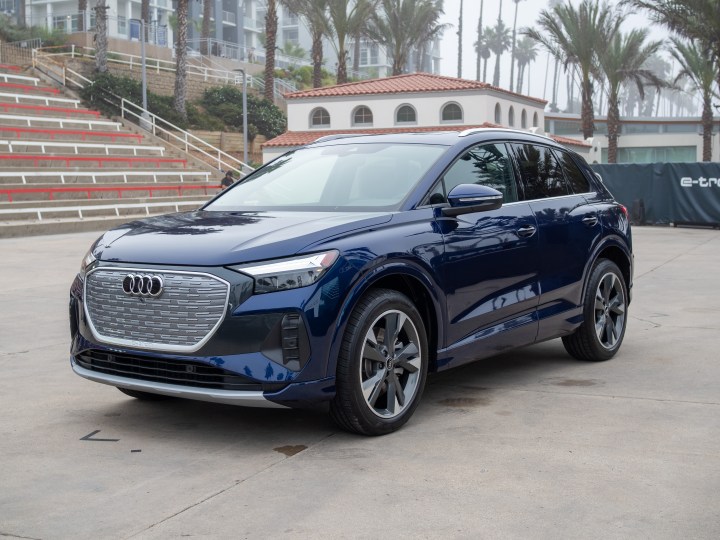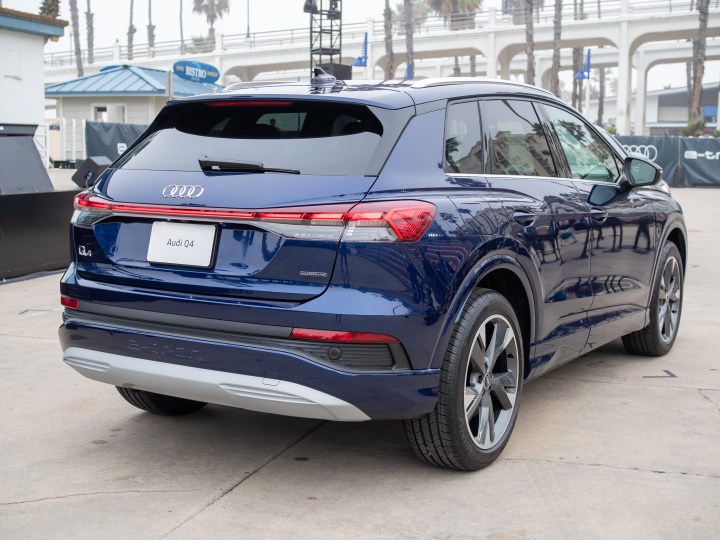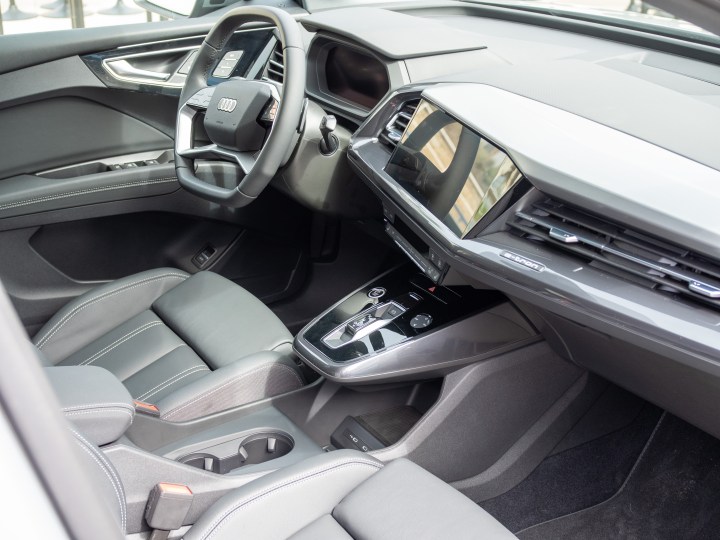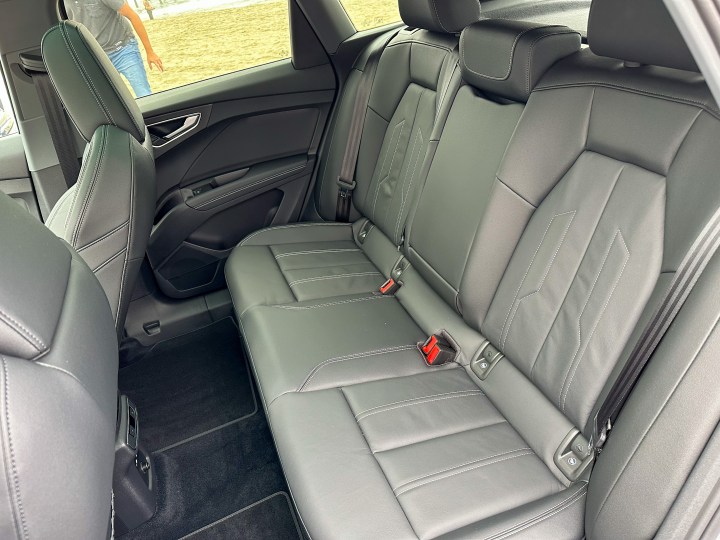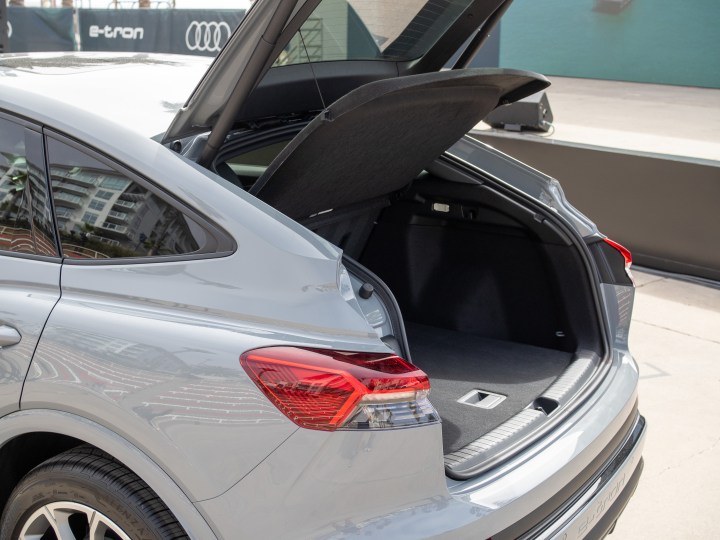Audi, like so much of the car industry, dipped its toe into EV production starting with splashy, aspirational models. The E-Tron SUV and E-Tron GT sport sedan are stunning and powerful, but even the more mainstream of the two starts at $71,000. With sights set on shifting a large portion of its production to EVs, it’s this car, the 2023 Q4 E-Tron, that is Audi’s most significant EV yet.

Starting under $50,000, this EV-only comfortably sized 5-seat SUV is the new entry point for electric Audis. But the fact that it’s electric actually isn’t particularly interesting, and that’s by design.
The best thing the Q4 E-Tron does is … just be an Audi. The Audi representatives at the launch event I’m attending were incredibly transparent and said exactly that; they feel that when you remove the combustion engine and replace it with an electric powertrain, not a whole lot changes — it simply lets the qualities Audi is known for shine through.
Setting off on a roughly 75-mile test drive, that’s apparent from the start. The fit and finish of every panel and piece of trim on the outside are superb. The doors close with a satisfying thud; except for the standard powered rear hatch, of course. The leather seats, soft-touch plastics, and natural finish wood veneers on the interior feel appropriate for a car at this price. Sit in a Q4 E-Tron, and there’s effectively no indication of whether there’s an engine under the hood.
First, you notice it’s an Audi. Then, you notice it’s an EV. That’s a good thing.
Of course, that’s until you set off on your journey. This dual-motor “Q 50” Quattro model is silent and smooth at lower speeds, but comes alive quickly in a way that will shock you if you’ve never been in an EV, but that will feel comfortably quick if you have. The 295 horsepower is above average for its class when compared to gasoline options, and it provides more power than most people would expect. Getting up to highway speeds on even a short on-ramp is no concern, nor is making a pass or jumping into a gap at any legal speed range.
Though the Q4 E-Tron is in no way designed to be a sporty SUV, it’s spry and lively and can hold its own on twisty roads. You feel the weight of the car shift under braking and hard turns, while the traction control regularly intervenes to keep you shiny-side up, particularly when getting into the power exiting a turn. But why spend any more time talking about this … you’re not pushing the limits of handling while you drive 10 miles to your local Whole Foods after picking up your kid from school.
The main driving dynamic I’d like to see changed is the way the braking system feels. The pedal is way too soft, and tipping into a soft brake pedal in a 5,000-pound car doesn’t instill confidence in the braking performance. That is, unless you’re aggressively using the regenerative braking through the steering wheel paddles or the “B” drive mode, where you can get close to full one-pedal driving, if you’re so inclined.
The Q4 E-Tron can handle way more sporty driving than you’re ever going to do with it.
On normal residential and arterial roads, or using adaptive cruise control on the freeway, the Q4 E-Tron shows its value. It’s comfortable, composed, and quiet at all speeds. Being that I’m driving in Southern California, it wasn’t uncommon to cruise at 80 mph on the freeway. There’s surprisingly little wind noise, and adequate tire noise (from these economical all-seasons) to deal with. Again, it feels like a $50,000-something SUV should.
There is a base “Q 40” model with just rear-wheel drive from a single motor, and a sharp cut to just 201 horsepower. If I were to regularly load up the Q4 E-Tron with 2-4 people and cargo, I would be a tad concerned about the power. Considering it comes in at nearly 5,000 pounds itself (thank you, batteries!), I’d be surprised if it could reach 60 mph under 8 seconds, which is quite slow. Quattro would be a must for me, but with a $5,000 price jump from the base model I imagine it’s going to keep some people down at the base model if they’re stretching up into the luxury segment.
My nearly top-of-the-line Q 50 model stickered north of $60,000 thanks to the S-Line package — with sportier styling, fancier seats, and a flat-bottomed steering wheel — and the Prestige package bringing all of the usual comfort and tech features including a heads-up display with augmented reality navigation.
The interior ergonomics of the Q4 E-Tron are good, but not a great match for a person of my height. At 6’4″ I wouldn’t expect to fit in every midsize SUV comfortably, and this one, to its credit, gets pretty close. The front seat is soft and comfortable, with a bit of extra bolstering in these S-Line seats. But the floor feels abnormally high — presumably due to the battery pack underneath — which brings my legs far too high for my liking. My knees are up near the steering column, even with the wheel at its highest position.
If you’re smaller than me, you’ll fit great — and no matter your size you can appreciate the small thoughtful touches Audi sprinkled throughout the cabin. There are huge pockets at the top of each front door capable of holding a 1.5L water bottle, and smaller version in the back doors. The front door panels are also sculpted nicely, and when paired with the layout of the cabin provided even me with plenty of room from the waist up.
The dashboard is pushed way ahead of you, as are the A pillars, providing you with a ton of glass up front. And with no transmission tunnel between you and your passenger, the center console is low and unobtrusive. You get a simple gear selector, and underneath a huge storage area for all of your random junk. Plus, there’s an excellent wireless charger that has a springy clip that holds the phone vertically up against the charger. No more worrying about the phone sliding around or flying out when you’re in corners or rough roads. (You even get a pop-up on your center screen when charging starts.)
The front of the cabin is a very nice place to be — unless you have long legs.
Tech-wise, Audi is near the top of the pack. The driver’s gauge screen is crisp, colorful, and customizable. Switching between views using the steering wheel touch pads and buttons is dead simple, and you always have what you need at a glance. If you need more, the driver-oriented center screen has you covered with a solid MMI system — plus wireless Android Auto and Apple CarPlay.
Chances are you’ll spend most of your time in one of those (base models don’t even have built-in navigation), but if you choose to use the built-in system just be ready for things to take a few extra beats and have a lower frame rate than your phone or tablet. It’s a bit disappointing at this price to deal with unresponsive buttons and stuttering animations, but sadly that’s to be expected in most of the car world.

My test car had the optional heads-up display with “augmented reality” navigation, which was really nice. It provides every bit of information you need, and the AR feature surprised me with its accuracy. It highlights the car(s) in front of you it’s identifying for adaptive cruise control, so you’re never playing a guessing game on your follow distance, and it shows clear and simple arrows for your turns and navigation prompts. The arrows display as if they’re roughly 30 feet in front of you, starting out subtly, and increase in size to indicate right when and where you should make a turn.
The only catch? You can’t see the heads-up display with sunglasses on. And if you’ll remember, I was driving in Southern California … and made ample use of the large glass sunroof. Yeah, bad combo. This isn’t an Audi-specific problem, to be clear, but make note if you live somewhere with ample sunshine: skip the heads-up display.
Because of the packaging of the EV batteries and motors that push the wheels further toward the front and rear than “normal,” the Q4 E-Tron has an interesting size profile. On the outside, it lands at a length close to that of a midsize Q5 SUV, but with a width more like a compact Q3 — that’s absolutely going to help you in narrow streets and small parking garages in cities, right where Audi sees most of its customers living.
But crucially, the passenger area — aka between the dashboard and the backrest of the back seats — is comparable to a full-size Q7. Despite my immense height, and the floor being higher than I’d expect, I could comfortably sit in the back seat behind my own seating position, and also sit side-by-side with another person over 6 feet tall. That just isn’t typical for this class of SUV, and is a huge perk of this packaging.
The restrained, traditional styling of the Q4 E-Tron isn’t turning heads, but that’s actually a win.
Audi design may not be your particular cup of tea, but this is considerably nicer (or at least, less controversial) looking than BMW’s recent EV SUVs; and there’s a character and thoughtfulness to the Q4 E-Tron’s design that simply isn’t present in the Tesla Model Y. As I said from the jump, nothing about the Q4 E-Tron design suggests that it’s an EV, which I feel the average Audi buyer actually prefers. This isn’t a head-turner, and doesn’t shout to the world that you have an electric car. It’s just a nice-looking car that generally blends in and happens to be an EV.
The “sportback” version of the Q4 E-Tron is, predictably, identical to the standard version in the front half of the car. Same driving position, same visibility, same features and configuration options. Once you get to the back seats, things get tight — but you expected that. My 6’4″ frame has to fold uncomfortably to get into the back seat; I simply can’t fit upright. Other journalists on this trip who come in under 6 feet were more comfortable, and I’m sure the sportback would feel plenty spacious for a child. But to my eyes the standard SUV actually looks better — and of course it has more cargo room, and is cheaper! Just get the SUV so you can do SUV things.
Comfortably cruising back to our departure point to complete my test loop, the driver screen showed I had lost roughly 100 miles of indicated range over the 75 miles I physically traveled. And to be clear, I didn’t exactly go easy on my drive. I spent about half of the time in either “Auto” or “Efficiency” drive modes, but the rest of the time split between “Comfort” and the sportiest “Dynamic” mode — the latter used liberally when I climbed up and over the twisty mountain roads northeast of San Diego.
My indicated energy consumption for the trip was 2.6 miles per kWh, which if applied to the full 82 kWh battery would equate to roughly 210 miles out of a complete charge. That’s a bit lower than the rated 236 miles, but I imagine when the average person gets behind the wheel and keeps their foot off of the floorboard, they could reach the indicated range.

Whether that’s “enough” range for you is a personal assessment that unfortunately requires a lot of follow-up questions and probably a spreadsheet. With a reliable 200-plus mile range and the ability to charge 5-80% in a bit over a half hour (given the stars align with a proper charger), most people can make do with this range; even if they don’t think they can.
A Tesla Model Y provides 75-100 miles more, and the great Supercharger network, but starts at $66,000 — that’s where the Q4 E-Tron tops out with every available option box ticked. And for me, the Q4 is better designed, better made, and is overall just a nicer car. The Mercedes EQB is a closer competitor, with a 245-mile range in its “300” trim, but it also starts at $55,000 (nearly $59,000 in “350” trim) — that somehow makes the Q4 E-Tron look like a value-conscious choice in this segment.
This isn’t the aspirational EV that’ll have you drooling. It’s the one you’ll actually buy.
This is the SUV that Audi needs to both keep up with the car industry’s direction and hit its own electrification goals. It’s also the kind of EV that the broadest segment of the car-buying public actually wants. Not everyone desires a shouty, unique, attention-grabbing car. A huge portion of cars sold are frankly boring, and that applies even to people who have the disposable income to buy a $50,000 luxury-brand SUV. The Audi Q4 E-Tron is for those buyers; they’ll love it.

Disclosure: Audi USA paid for my travel and accommodations to attend this product launch event. The company was not provided copy approval, nor did it receive any special consideration in the resulting content.
